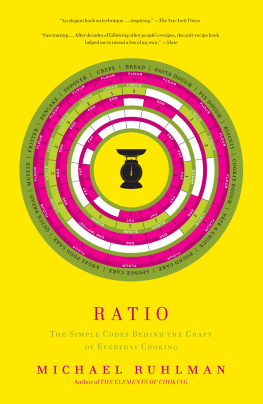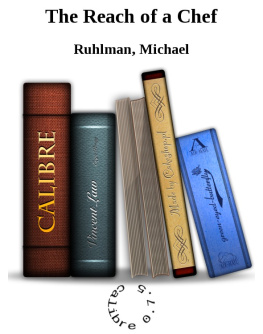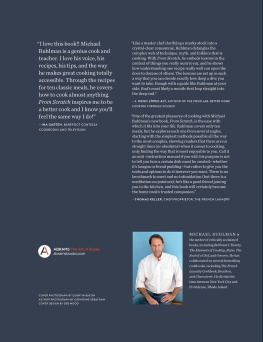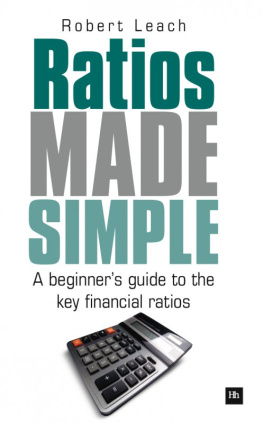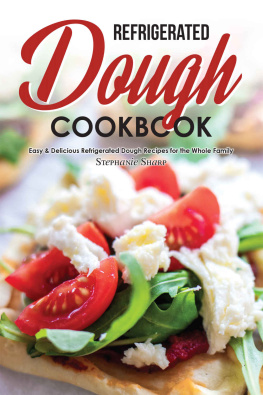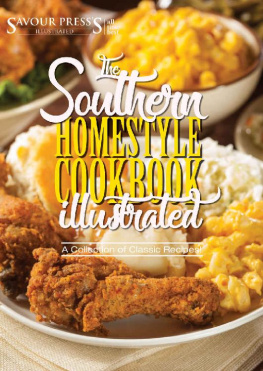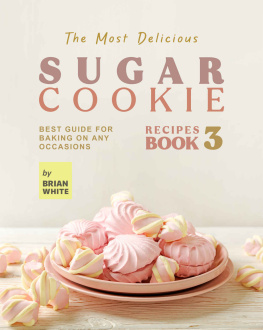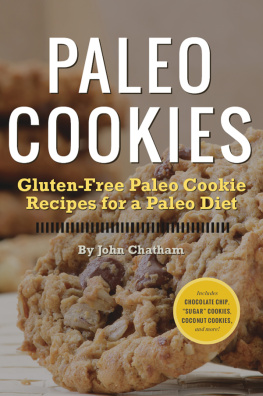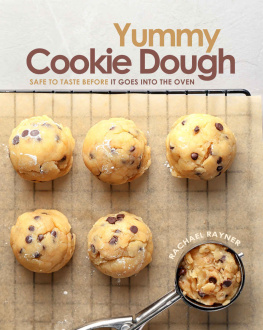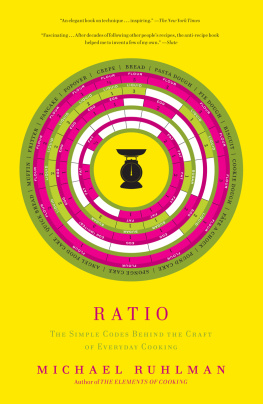A LSO BY M ICHAEL R UHLMAN
The Elements of Cooking
The Making of a Chef
The Soul of a Chef
The Reach of a Chef
COOKBOOK COLLABORATIONS
The French Laundry Cookbook
A Return to Cooking
Bouchon
Charcuterie:
The Craft of Salting, Smoking and Curing
GENERAL NONFICTION
Boys Themselves
Wooden Boats
Walk on Water
House: A Memoir

SCRIBNER
A Division of Simon & Schuster, Inc.
1230 Avenue of the Americas
New York, NY 10020
Copyright 2009 by Michael Ruhlman
All rights reserved, including the right to reproduce this book or portions thereof in any form whatsoever. For information address Scribner Subsidiary Rights Department, 1230 Avenue of the Americas, New York, NY 10020.
SCRIBNER and design are trademarks of The Gale Group, Inc., used under license by Simon & Schuster, Inc., the publisher of this work.
Library of Congress Control Number: 2008032679
eISBN-13: 978-1-4165-6612-0
eISBN-10: 1-4165-6612-0
Photographs by Donna Turner Ruhlman
Visit us on the World Wide Web:
http://www.SimonandSchuster.com
For Uwe Hestnar
Contents
The Ratios
Doughs
Bread = 5 parts flour: 3 parts water (plus yeast and salt)
Pasta Dough = 3 parts flour: 2 parts egg
Pie Dough = 3 parts flour: 2 parts fat: 1 part water
Biscuit = 3 parts flour: 1 part fat: 2 parts liquid
Cookie Dough = 1 part sugar: 2 parts fat: 3 parts flour
Pte Choux = 2 parts water: 1 part butter: 1 part flour: 2 parts egg
Batters
Pound Cake = 1 part butter: 1 part sugar: 1 part egg: 1 part flour
Sponge Cake = 1 part egg: 1 part sugar: 1 part flour: 1 part butter
Angel Food Cake = 3 parts egg white: 3 parts sugar: 1 part flour
Quick Bread = 2 parts flour: 2 parts liquid: 1 part egg: 1 part butter
Muffin = 2 parts flour: 2 parts liquid: 1 part egg: 1 part butter
Fritter = 2 parts flour: 2 parts liquid: 1 part egg
Pancake = 2 parts flour: 2 parts liquid: 1 part egg: part butter
Popover = 2 parts liquid: 1 part egg: 1 part flour
Crepe = 1 part liquid: 1 part egg: part flour
Stocks and Sauces
Stock = 3 parts water: 2 parts bones
Consomm = 12 parts stock: 3 parts meat: 1 part mirepoix: 1 part egg white
Roux = 3 parts flour: 2 parts fat
Thickening Ratio = 10 parts liquid: 1 part roux
Beurre Mani = 1 part flour: 1 part butter (by volume)
Slurry = 1 part cornstarch: 1 part water (by volume)
Thickening Rule = 1 tablespoon starch will thicken 1 cup liquid
Farir
Sausage = 3 parts meat: 1 part fat
Sausage Seasoning = 60 parts meat/fat: 1 part salt
Mousseline = 8 parts meat: 4 parts cream: 1 part egg
Brine = 20 parts water: 1 part salt
Fat-Based Sauces
Mayonnaise = 20 parts oil: 1 part liquid (plus yolk)
Vinaigrette = 3 parts oil: 1 part vinegar
Hollandaise = 5 parts butter: 1 part yolk: 1 part liquid
Custards
Free-Standing Custard = 2 parts liquid: 1 part egg
Crme Anglaise = 4 parts milk/cream: 1 part yolk: 1 part sugar
Chocolate Sauce = 1 part chocolate: 1 part cream
Caramel Sauce = 1 part sugar: 1 part cream
What Is a Ratio and Why Is It Important?
A culinary ratio is a fixed proportion of one ingredient or ingredients relative to another. These proportions form the backbone of the craft of cooking. When you know a culinary ratio, its not like knowing a single recipe, its instantly knowing a thousand. Here is the ratio for bread: 5 parts flour: 3 parts water.
This means that if you combine 5 ounces of flour and 3 ounces of water, or 20 ounces of flour and 12 ounces of water, or 500 grams of flour and 300 grams of water, you will, if you mix it properly, have a good bread dough. You need a small amount of yeast, but the exact amount is hugely variable as it turns out, so thats not a meaningful part of the ratio. You need salt for flavor, but that is a matter of taste to a large degree. And you need to mix the dough until it has enough elasticity to contain the gas released by the yeast. So while there are rules to follow and issues of technique, these are not part of the ratio.
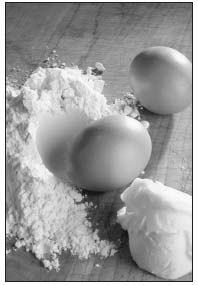
Three of your most valuable tools in the kitchen: flour, eggs, and butter.
What can you do, now that you know the bread ratio? You can make fresh bread without opening a single book or scouring a website for random recipes, and you can make as much or as little as you like. That 500 grams of flour or 20 ounces of flour with the water, a big pinch of dry yeast, and 2 big pinches of salt make a good loaf of bread. But if you want to liven it up, add a tablespoon of freshly chopped rosemary and a head of roasted garlic and stretch it out for a roasted garlic and rosemary ciabatta. Other fresh herbs such as thyme, sage, and oregano work beautifully, too. Or use other intense, flavorful ingredients: poblano and chipotle peppers, kalamata olives and walnuts, chocolate and cherries, pistachios and cranberries. Caramelized onion! A sausage! Cheese! The variations are limitless because you know the ratio, 5 parts flour, 3 parts water. Eventually youll feel comfortable using some whole grain flour in there or potato.
Of course, many, many variables contribute to the end resulthow long the final rise is, how hot the oven, how well you shaped the dough, and so onand addressing those variables can make baking feel dauntingly complicated. Indeed, baking that perfect loaf of bread every time takes practice and thoughtfulness; whole books are devoted to it. But on the most basic level, baking bread is not complicated.
Feel like making fresh pizza? Ten ounces of flour, 6 ounces of water, a pinch of yeast, and a pinch of salt will give you dough for a medium pie. Many recipes for pizza dough include a sugar of some kindif thats to your taste, add a tablespoon of sugar or honey (youll find this increases yeast activity). Many add a flavoring of olive oil. Go for it. Stick to the 5:3 ratio and youre golden.
Want an easy delicious white sandwich bread for the kids? Same ratio (and maybe add some wheat germ for additional fiber and some honey for flavor and sweetness). But still its 5 to 3. Just cook it more gently, 350F for an hour or so, until its very hot inside.
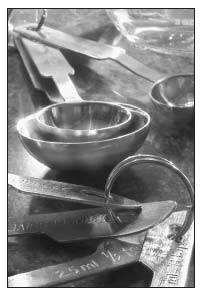
All measuring spoons are not alike. Avoid boutiquey, porcelain, plastic, or gimmicky measuring devices.
This book is composed of such ratios.
Cooking is infinitely nuanced and there are ultimately too many variables to account for in any single recipe (the ambient humidity, how long a bag of flour has been sitting in the cupboard), so its important to remember, as my first culinary instructor notes, how well ratios work is directly proportionate to the ratio of common sense applied to them. Good technique must be used in conjunction with the ratiowhich is why this is a book and not a sheet of paper. You need the ratio and the users manual. Technique must be practicedyou can never stop getting better.
This is important: my aim isnt to make the perfect bread or pasta or mayonnaise or biscuitsthe best Ive ever had. Its to set a baseline to work from, to codify the fundamentals from which we work and which we work off of. When I was writing Walk on Water, about a renowned surgeon, more than one doctor noted the common saying, great is the enemy of good, meaning that when surgeons strive for greatness, they can cause harm when they might otherwise not have harmed had they simply strived for good. Ive worked with the greatest perfectionist there is in the cooking world, and I love that hunt for the perfect sauce, the perfect custard, but here Im after good. Only when we know good can we begin to inch up from good to excellent.

